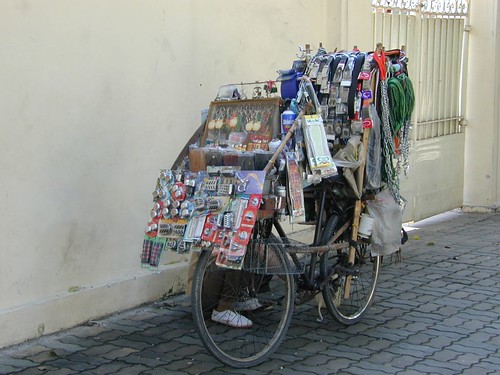My son and I swung by the bike collective while running errands yesturday to pick up a couple bells and look into adding panniers to our rig. We are on a very tight budget, so we have been trying to get by with spending as little as possible, but the ride last weekend convinced me of two things: bells are an essential safety device, and we need more cargo capacity, big time. I had to accept that, if we were going to make this experiment work, we needed to have a few key pieces of equipment.
Luckily, the collective where I bought my bike offers a very generous warranty and free labor during the first month after purchase. So I can have my panniers mounted on the front of my bike, bit of a tricky job --especially with my old-school breaks that extend out at right angles over the wheel-- and not have to pay for the labor.
I wonder if some people are reluctant to shift to bikes due to financial concerns, and/or because they arnt sure what they they really need among the huge variety of accessories and equipment out there. Since I have managed on a "starving-student/single-parent budget", I thought I would wade in with my perspective.
So far the bike experiment has cost about $35 (for headlight, drink cages and bells) the rack for the panniers will be another $30. The collective sells these 5 gallon plastic buckets that mount onto the racks for $50 per pair (far cheaper than the pannier bags), but it is a very simple design that I can replicate at home for about $10, bringing my cycling investment to about $75. I have been tracking my millage and am fast approaching my first "century", although cost savings is not my primary goal in riding, I derive great satisfaction knowing that during that same month, my friends who drive have spent an average of $200 operating their cars. And, of course, my investment has been in durable goods, rather than in converting fuel into pollution
Because I use a Trail-A-Bike to bring my son along on trips, a cargo trailer or rear rack is out of the question, but bringing my son also greatly increases my cargo needs (extra layers to keep him comfortable, snacks, his Taekwan-Do uniform, etc). The handlebar mounted basket I have now is just not sufficient, and the messenger bag I carry is maxed out with my textbooks and school supplies, so I am opting for a front rack that will hold a pair of 5 gallon buckets on either side of the front wheel. The buckets will keep their contents clean and dry, prevent crushing of delicate items, and they detach, so I can bring the buckets into stores for shopping, and into the house at night, allowing me to pack for the next morning and avoid forgetting things during our crazy, bleary-eyed morning rush out the door.
They other key to succusful utility cycling, I have discovered, is wearing layers that allow me to adjust to changes in weather conditions and my own internally generated heat. This goes double for my son, when traveling with kids the simple fact is that if they are miserable, your gonna be miserable too. When we tried to make the shift to bikes last fall we were thwarted in large part by the increasingly inclement weather (wettest winter in 36 years), and not being able to carry what we needed. One thing about wearing layers is that, as you peel them off, you need someplace to put them, and when you travel with kids you need places to stow the snacks, sports equipment, uniforms, etc. Different families are going to have different needs, and find different solutions more or less usefull. The trick is to figure out what you need, what obsticles are in your way, and how to solve those issues and meet those needs. Luckily, there are cargo and gear options out there for every possible need.
Budget biking requires a bit of a dance between making due and shooting one's self in the foot, you need a minimum degree of comfort, security and organization, or your gonna quit. That has been my experience, anyway. The good news is that you can spread some of these purchases over time, and fit them into your budget. I have managed to work it out so that I only spend a little here and a little there on bike related expenses, generally less than $30 per month on, which seems to fit with what I have read about national averages:
Per mile traveled, bicycle riding costs the cyclist less than half as much as mass transit and only one-quarter as much as driving — even assuming cyclists must replace their bicycles every three years due to bicycle theft and bad pavement. According to Transportation Alternatives Bicycle Blueprint, motorists can save over $1000 annually by biking to work, [http://www.transalt.org/blueprint/chapter1/chapter1g.html] Biking to work/school and errands even one day a week can allow you to save more than the cost of gearing up!
Helmet -- you only got one head, and your gonna need it later:
$30
Headlight for early morning commute and extra visibility all day:
$20
Gloves, to fend off the wind as you go hurtling through the early morning chill:
$5
Bell/horn to alert drivers that bikes exist:
$10
Cages for drink bottles:
$5
Pannier rack and buckets:
$40
Subverting the Dominant Paradigm: Priceless
 Hows this for inspiration:
Hows this for inspiration:
